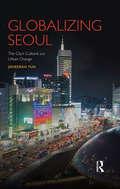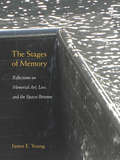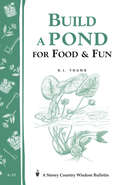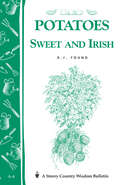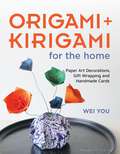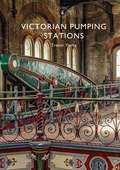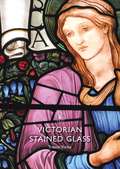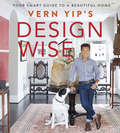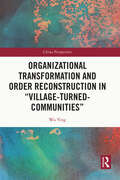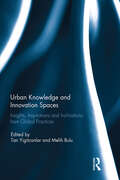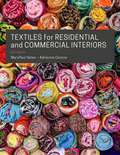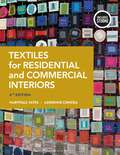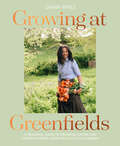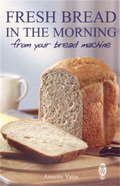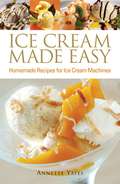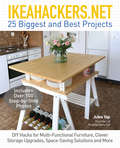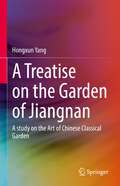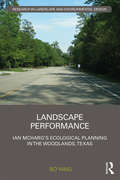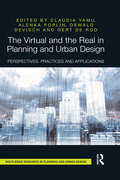- Table View
- List View
Globalizing Seoul: The City's Cultural and Urban Change (Planning, History and Environment Series)
by Jieheerah YunIn the decades following the 1997 Asian economic crisis, South Korea sought segyehwa (globalization). Evidence of this is no more evident than in the country’s capital, Seoul, where urban development has been central to making the city a global hub and not just the centre of the national economy. However, recent development projects differ from those of the past in that they no longer focus solely on economic efficiency, but on the deployment of a new urban aesthetics. As Jieheerah Yun reveals in Globalizing Seoul: The City’s Cultural and Urban Change, the pursuit of globalization and the rebranding of Seoul’s image from hard industrial city to soft cultural city have shaped the urban development of the city. Following a brief urban history of Seoul, she focuses on two key themes. In the first, how globalization has contributed to refashioning Korean traditions, she analyzes the policies and actions to preserve Korean folk houses and pre-industrial street layouts, looking in detail at the Bukchon and Insadong areas of the city. Her second theme is an examination of migration and the generation of new minority neighbourhoods amidst the segyehwa policies and the state’s efforts to build a multicultural society. In detailed case studies of the redevelopment of Dongdaemun Market as part of rebranding Seoul as the ‘world design capital’ and of the Itaewon area as both a Special Tourist Zone and a Global Cultural Zone, she shows how multi-ethnic neighbourhoods are threatened by lack of consideration for economic justice and housing provision.
Globalizing Seoul: The City's Cultural and Urban Change (Planning, History and Environment Series)
by Jieheerah YunIn the decades following the 1997 Asian economic crisis, South Korea sought segyehwa (globalization). Evidence of this is no more evident than in the country’s capital, Seoul, where urban development has been central to making the city a global hub and not just the centre of the national economy. However, recent development projects differ from those of the past in that they no longer focus solely on economic efficiency, but on the deployment of a new urban aesthetics. As Jieheerah Yun reveals in Globalizing Seoul: The City’s Cultural and Urban Change, the pursuit of globalization and the rebranding of Seoul’s image from hard industrial city to soft cultural city have shaped the urban development of the city. Following a brief urban history of Seoul, she focuses on two key themes. In the first, how globalization has contributed to refashioning Korean traditions, she analyzes the policies and actions to preserve Korean folk houses and pre-industrial street layouts, looking in detail at the Bukchon and Insadong areas of the city. Her second theme is an examination of migration and the generation of new minority neighbourhoods amidst the segyehwa policies and the state’s efforts to build a multicultural society. In detailed case studies of the redevelopment of Dongdaemun Market as part of rebranding Seoul as the ‘world design capital’ and of the Itaewon area as both a Special Tourist Zone and a Global Cultural Zone, she shows how multi-ethnic neighbourhoods are threatened by lack of consideration for economic justice and housing provision.
The Stages of Memory: Reflections on Memorial Art, Loss, and the Spaces Between (Public History in Historical Perspective)
by James E. YoungFrom around the world, whether for New York City's 9/11 Memorial, at exhibits devoted to the arts of Holocaust memory, or throughout Norway's memorial process for the murders at Utøya, James E. Young has been called on to help guide the grief stricken and survivors in how to mark their losses. This poignant, beautifully written collection of essays offers personal and professional considerations of what Young calls the "stages of memory," acts of commemoration that include spontaneous memorials of flowers and candles as well as permanent structures integrated into sites of tragedy. As he traces an arc of memorial forms that spans continents and decades, Young returns to the questions that preoccupy survivors, architects, artists, and writers: How to articulate a void without filling it in? How to formalize irreparable loss without seeming to repair it? Richly illustrated, the volume is essential reading for those engaged in the processes of public memory and commemoration and for readers concerned about how we remember terrible losses.
Build a Pond for Food & Fun: Storey's Country Wisdom Bulletin A-19 (Storey Country Wisdom Bulletin)
by D. J. YoungSince 1973, Storey's Country Wisdom Bulletins have offered practical, hands-on instructions designed to help readers master dozens of country living skills quickly and easily. There are now more than 170 titles in this series, and their remarkable popularity reflects the common desire of country and city dwellers alike to cultivate personal independence in everyday life.
Potatoes, Sweet and Irish: Storey's Country Wisdom Bulletin A-04 (Storey Country Wisdom Bulletin)
by D. J. YoungSince 1973, Storey's Country Wisdom Bulletins have offered practical, hands-on instructions designed to help readers master dozens of country living skills quickly and easily. There are now more than 170 titles in this series, and their remarkable popularity reflects the common desire of country and city dwellers alike to cultivate personal independence in everyday life.
Origami and Kirigami for the Home: Paper Art Decorations, Gift Wrapping and Handmade Cards
by Wei YouA colourful guide (with accompanying online video tutorials) to creating decorative pieces for the home, parties and events alongside ideas for presents, cards and gift wrapping.Origami is the Japanese art of paper folding and kirigami is the traditional art of paper cutting. In this beautifully illustrated book, paper artist Wei You introduces you to over 30 unique projects for your home that can be made by anyone, regardless of experience. After learning the basic folds, discover different paper types – try out pretty handmade ones such as mulberry and decorative washi, or experiment with the full rainbow of classic origami paper – and find a wealth of ideas from table decorations and tiles, to gift wrap and seasonal decorations. In no time at all you will have the skills to craft delicate roses and stylish card holders, striking wall art to decorate your home, parties and events, as well as unique eco-friendly ideas for presents and cards. Easy-to-follow instructions, photographs and diagrams guide you step by step through traditional and contemporary designs and accompanying videos for each origami project will ensure you develop your skills to create some truly impressive makes. Paper is more than just a blank page to write on – grab yourself a bundle and get started folding, cutting and creating your own paper magic!
Origami and Kirigami for the Home: Paper Art Decorations, Gift Wrapping and Handmade Cards
by Wei YouA colourful guide (with accompanying online video tutorials) to creating decorative pieces for the home, parties and events alongside ideas for presents, cards and gift wrapping.Origami is the Japanese art of paper folding and kirigami is the traditional art of paper cutting. In this beautifully illustrated book, paper artist Wei You introduces you to over 30 unique projects for your home that can be made by anyone, regardless of experience. After learning the basic folds, discover different paper types – try out pretty handmade ones such as mulberry and decorative washi, or experiment with the full rainbow of classic origami paper – and find a wealth of ideas from table decorations and tiles, to gift wrap and seasonal decorations. In no time at all you will have the skills to craft delicate roses and stylish card holders, striking wall art to decorate your home, parties and events, as well as unique eco-friendly ideas for presents and cards. Easy-to-follow instructions, photographs and diagrams guide you step by step through traditional and contemporary designs and accompanying videos for each origami project will ensure you develop your skills to create some truly impressive makes. Paper is more than just a blank page to write on – grab yourself a bundle and get started folding, cutting and creating your own paper magic!
Victorian Pumping Stations (Shire Library #846)
by Trevor YorkeVictorian pumping stations are colourful cathedrals of utility. Their imposing and striking exteriors enclose highly decorative cast-iron frames, built to encage powerful steam engines. They are glorious buildings which display the Victorians' architectural confidence and engineering skills. More than that, they represent a key part of the story of urban development and how our towns and cities were shaped in this period of ground-breaking invention and civic pride. In this illustrated guide, Trevor Yorke tells the story of Victorian pumping stations and explains why they were built in such a flamboyant manner, describing their architectural features and showing how their mighty steam engines worked. He includes examples of their glorious interior decoration from pumping stations across the country and provides a detailed list of those which are open to visitors.
Victorian Pumping Stations (Shire Library #846)
by Trevor YorkeVictorian pumping stations are colourful cathedrals of utility. Their imposing and striking exteriors enclose highly decorative cast-iron frames, built to encage powerful steam engines. They are glorious buildings which display the Victorians' architectural confidence and engineering skills. More than that, they represent a key part of the story of urban development and how our towns and cities were shaped in this period of ground-breaking invention and civic pride. In this illustrated guide, Trevor Yorke tells the story of Victorian pumping stations and explains why they were built in such a flamboyant manner, describing their architectural features and showing how their mighty steam engines worked. He includes examples of their glorious interior decoration from pumping stations across the country and provides a detailed list of those which are open to visitors.
Victorian Stained Glass (Shire Library)
by Trevor YorkeA beautifully illustrated guide to the world of Victorian stained glass and its manufacturers and designers.Victorian stained glass – magnificent, colourful and artistic – adorns countless British churches, municipal buildings and homes. Across the decades, several artistic movements influenced these designs, from the Gothic Revival, through the Arts and Crafts Movement and into Art Nouveau as a new century dawned. Historian Trevor Yorke shows how craftsmen re-learned the lost medieval art of colouring, painting and assembling stained glass windows – but also, in this age of industry, how windows were templated and mass produced. Showcasing the exquisite glass generated by famous designers such as A.W.N. Pugin, Pre-Raphaelites William Morris and Edward Burne-Jones, and by leading manufacturers such as Clayton and Bell, this beautifully illustrated book introduces the reader to many wonderful examples of Victorian stained glass and where it can be found.
Vern Yip's Design Wise: Your Smart Guide to a Beautiful Home
by Vern YipHGTV and Trading Spaces' trusted interior designer Vern Yip shares his favorite design secrets to creating living spaces that have flow, balance, and harmony--while opening his doors to show how he's made these principles work in his own beloved homes. This New York Times bestseller provides both the inspiration and the clear, essential guidelines you need to create a home that perfectly reflects you. Have you ever wondered exactly how high to hang your artwork? How about the light fixture over your dining table? Do you know how to ideally size a rug for any room, or the best way to arrange your furniture? Beloved designer Vern Yip answers these questions, and more, by revealing the right formulas and measurements that can make any room feel just "right." And once you know these key design principles, you're free to confidently create a home that uniquely celebrates your needs and style. With gorgeous photos throughout, Vern Yip's Design Wise is a book you'll return to again and again.
Organizational Transformation and Order Reconstruction in "Village-Turned-Communities" (China Perspectives)
by WU YingSince the beginning of the 21st century, a state-led urbanization has evolved into a "city management" in China: a large number of villages were demolished; cultivated land was centralized; and peasants went to live in apartments, which led to the widespread emergence of "village-turned-communities". This title explores the evolving and complex relationship between the urbanization of land and people – two core components of China’s urbanization strategy. What role does the government play in creating conflicts around these two aspects of urbanization? What role can it play in adjudicating them? To answer these questions, the author examines rural migrants’ experience in integrating and being integrated into the cities. Through a three-year investigation in Beijing, Shandong, Wuhan and Yunnan, the author shows how government policies can either engender or mitigate conflicts, as well as identifies integrated governance as an effective approach to urbanization of both land and people. This title is awarded the top ten Chinese sociology books in 2019. Students and scholars of sociology, politics and public administration will benefit from this book.
Organizational Transformation and Order Reconstruction in "Village-Turned-Communities" (China Perspectives)
by WU YingSince the beginning of the 21st century, a state-led urbanization has evolved into a "city management" in China: a large number of villages were demolished; cultivated land was centralized; and peasants went to live in apartments, which led to the widespread emergence of "village-turned-communities". This title explores the evolving and complex relationship between the urbanization of land and people – two core components of China’s urbanization strategy. What role does the government play in creating conflicts around these two aspects of urbanization? What role can it play in adjudicating them? To answer these questions, the author examines rural migrants’ experience in integrating and being integrated into the cities. Through a three-year investigation in Beijing, Shandong, Wuhan and Yunnan, the author shows how government policies can either engender or mitigate conflicts, as well as identifies integrated governance as an effective approach to urbanization of both land and people. This title is awarded the top ten Chinese sociology books in 2019. Students and scholars of sociology, politics and public administration will benefit from this book.
Urban Knowledge and Innovation Spaces: Insights, Inspirations and Inclinations from Global Practices
by Tan Yigitcanlar Melih BuluThe expansion of knowledge economy, globalization, and economic competitiveness has imparted importance of knowledge and innovation in local economies worldwide. As a result, integrating knowledge generation and innovation considerations in urban planning and development processes has become an important agenda for establishing sustainable growth and long-term competitiveness of contemporary cities. Today, making space and place that concentrate on knowledge generation and innovation is a priority for many cities across the globe. Urban knowledge and innovation spaces are integrated centres of knowledge generation, learning, commercialization and lifestyle. In other words, they are high-growth knowledge industry and worker clusters, and distinguish the functional activity in an area, where agglomeration of knowledge and technological activities has positive externalities for the rest of the city as well as firms located there. Urban knowledge and innovation spaces are generally established with two primary objectives in mind: to be a seedbed for knowledge and technology and to play an incubator role nurturing the development and growth of new, small, high-technology firms; and to act as a catalyst for regional economic development that promotes economic growth and contributes to the development of the city as a ‘knowledge or innovative city’. This book contains chapters reporting investigation findings on different aspects of urban knowledge and innovation spaces, such as urban planning and design, innovation systems, urban knowledge management, and regional science. It was originally published as a special issue of the Journal of Urban Technology.
Urban Knowledge and Innovation Spaces: Insights, Inspirations and Inclinations from Global Practices
by Tan YigitcanlarThe expansion of knowledge economy, globalization, and economic competitiveness has imparted importance of knowledge and innovation in local economies worldwide. As a result, integrating knowledge generation and innovation considerations in urban planning and development processes has become an important agenda for establishing sustainable growth and long-term competitiveness of contemporary cities. Today, making space and place that concentrate on knowledge generation and innovation is a priority for many cities across the globe. Urban knowledge and innovation spaces are integrated centres of knowledge generation, learning, commercialization and lifestyle. In other words, they are high-growth knowledge industry and worker clusters, and distinguish the functional activity in an area, where agglomeration of knowledge and technological activities has positive externalities for the rest of the city as well as firms located there. Urban knowledge and innovation spaces are generally established with two primary objectives in mind: to be a seedbed for knowledge and technology and to play an incubator role nurturing the development and growth of new, small, high-technology firms; and to act as a catalyst for regional economic development that promotes economic growth and contributes to the development of the city as a ‘knowledge or innovative city’. This book contains chapters reporting investigation findings on different aspects of urban knowledge and innovation spaces, such as urban planning and design, innovation systems, urban knowledge management, and regional science. It was originally published as a special issue of the Journal of Urban Technology.
Textiles for Residential and Commercial Interiors: - with STUDIO
by MaryPaul Yates Adrienne Concra"I adopt this text due to the strong applications within the fields of Interior Design and Architecture. It shows practical knowledge that students need upon graduation. It should be kept as reference for all new graduates." Victoria Runge, University of Tennessee, Chattanooga, USALearn how to select textiles for every type of residential and commercial interior. The book has the most current fiber and fabric information about household and institutional textiles, and commercial and residential textiles for upholstered furniture, windows, walls, and floorcoverings. More than 500 color line drawings and photographs illustrate fibers, yarns, fabrics, manufacturing equipment, coloring, finishings, and end products. Textiles for Residential and Commercial Interiors STUDIO-an online study tool! · Study smarter with self-quizzes featuring scored results and personalized study tips· Review vocabulary with flashcards PLEASE NOTE: Purchasing or renting this ISBN does not include access to the STUDIO resources that accompany this text. To receive free access to the STUDIO content with new copies of this book, please refer to the book + STUDIO access card bundle ISBN 9781501326660.
Textiles for Residential and Commercial Interiors: - with STUDIO
by MaryPaul Yates Adrienne ConcraLearn how to choose the right type of textile for your residential and commercial interior design. This book includes important information about fiber and fabrics for household and institutional textiles, and commercial and residential textiles. It also touches on specific design techniques such as the latest textile printing methods and technologies, the newest performance-related finishes, proper window treatment, and the best environmentally conscious sustainability approaches. The line drawings and photographs show yarns, weaving, manufacturing equipment, fibers, fabrics used in a variety of interior spaces, and many more. New to this Edition- Updated to include the newest codes and guidelines for fabric performance and evaluation - Exploration of new textile printing methods and technologies- Updated fire safety methods and flammability testing STUDIO Features Include- Study smarter with self-quizzes featuring scored results and personalized study tips- Review concepts with flashcards of terms and definitions Instructor Resources- Instructor's Guide to help integrate the text into your classroom- PowerPoint slides for every chapter
Growing at Greenfields: A Seasonal Guide To Growing, Eating And Creating From A Beautiful Scottish Garden
by Diana YatesDiana Yates shares her guide to creating a flower and veg garden from scratch, and how it turned out to be larder, source of home decoration and a place of restoration and healing, too. From planting for pollinators to growing a pumpkin patch and storing your homegrown produce, Diana takes us through the growing year at her home, Greenfields.
Fresh Bread in the Morning (From Your Bread Machine): From Your Bread Machine
by Annette YatesWake up to the aroma of fresh bread wafting through your kitchen every morning! A dream? No. With your bread machine, it's a reality. Push a button or two and transform what seems like a laborious, time-consuming and skilled process into a spectacularly easy affair. So why do you need this book when bread machines come with their own recipes? Well, such recipes vary, sometimes on the high side, in the amount of yeast, salt, sugar, fat and dried milk powder they contain. Annette Yates has set about reducing these ingredients and providing recipes for making loaves that are as natural as they can be. And they are delicious too. Or you can add extra ingredients - like herbs, spices, seeds, nuts, fruit, vegetables, honey, mustard and even chocolate! - and transform simple bread into something really special. Try it and see...
Ice Cream Made Easy: Homemade Recipes for Ice Cream Machines
by Annette YatesIce Cream Made Easy shows how to make luscious, creamy concoctions, light-and-airy yogurt mixtures and dairy-free ice creams, as well as refreshing fruit-filled sorbets, icy granitas and slushy drinks. And if that's not enough, there's a selection of dreamy toppings and sauces, plus some inspirational ideas for quick ice cream desserts.There are ices to suit any occasion (simple or stylish) at any time of the year from classic favourites like Vanilla or Chocolate to modern flavours like Strawberry Pavlova Ripple, Toasted Apple and Cinnamon, or Chunky Pecan and Maple.Don't worry if you haven't got an ice cream machine, as many of the recipes can be made by hand. Most are so easy to make and so scrumptious that you may not want to share them - you may want to indulge all by yourself!
IkeaHackers.Net: 25 Biggest and Best Projects: DIY Hacks for Multi-Functional Furniture, Clever Storage Upgrades, Space-Saving Solutions and More
by Jules YapTHINK OUTSIDE THE FLAT-PACK BOX: The ingenious team at IkeaHackers.net show you how to transform affordable IKEA products into creative new furniture and more...Step 1. Buy it at IKEA. Step 2. Open the box. Step 3. Throw away the instructions. Step 4. Have fun building your exciting new hack! By thinking outside the flat-pack box, author Jules Yap and the contributors to her wildly popular website IkeaHackers.net have come up with clever ways to repurpose IKEA's great products into even more useful and stylish furnishings for your home. Packed with ideas for every room, IKEA Hacks shows you how to mix-and-match, cut-and-paste, and saw-and-screw IKEA items in ways they never imagined. The inventive projects include a cat condo created using LACK tables, a children's playhouse constructed from KURA bed and TROFAST toy storage, and a Murphy bed made from PAX wardrobe, BALLSTAD doors and LUROY bed base. Each project comes complete with step-by-step instructions as well as full-colour illustrations and photos.
A Treatise on the Garden of Jiangnan: A study on the Art of Chinese Classical Garden
by Hongxun YangThis book presents a study into the art of Jiangnan classical garden. Jiangnan (“the south of the Yangtze River”) refers to the water network region along the lower reaches of the Changjiang River (formerly known as Yangtze River), where Jiangsu Province Chinese gardens were primarily constructed during the 16th and 17th centuries of the later Ming and early Qing dynasties. The Jiangnan garden, an architectural space where artificial and natural elements are combined, represents the elite of classical Chinese gardens and serves as a prime exemplar for its northern counterpart, the Ming and Qing imperial gardens.The book pursues an interdisciplinary approach, combining historical information with case studies and other methods. Charts and pictures are used to supplement and reinforce the conclusions drawn from the macro narrative, enhancing the authenticity and readability of the historical monographs. It represents the first study of the classical art of landscape design in China, offering readers an insightful introduction.
Landscape Performance: Ian McHarg’s ecological planning in The Woodlands, Texas (Routledge Research in Landscape and Environmental Design)
by Bo YangIan McHarg’s ecological planning approach has been influential since the 20th century. However, few empirical studies have been conducted to evaluate the performance of his projects. Using the framework of landscape performance assessment, this book demonstrates the long-term benefits of a renowned McHargarian project (The Woodlands town development) through quantitative and qualitative methods. Including 44 black and white illustrations, Landscape Performance systematically documents the performance benefits of the environmental, social, and economic aspects of The Woodlands project. It delves into McHarg’s planning success in The Woodlands in comparison with adjacent Houston developments, which demonstrated urban resilience after Hurricane Harvey in 2017. Lastly, it identifies the ingredients of McHarg’s ability to do real and permanent good. Yang also includes a number of appendices which provide valuable information on the methods of assessing performance in landscape development. This book would be beneficial to academics and students of landscape architecture and planning with a particular interest in Ian McHarg.
Landscape Performance: Ian McHarg’s ecological planning in The Woodlands, Texas (Routledge Research in Landscape and Environmental Design)
by Bo YangIan McHarg’s ecological planning approach has been influential since the 20th century. However, few empirical studies have been conducted to evaluate the performance of his projects. Using the framework of landscape performance assessment, this book demonstrates the long-term benefits of a renowned McHargarian project (The Woodlands town development) through quantitative and qualitative methods. Including 44 black and white illustrations, Landscape Performance systematically documents the performance benefits of the environmental, social, and economic aspects of The Woodlands project. It delves into McHarg’s planning success in The Woodlands in comparison with adjacent Houston developments, which demonstrated urban resilience after Hurricane Harvey in 2017. Lastly, it identifies the ingredients of McHarg’s ability to do real and permanent good. Yang also includes a number of appendices which provide valuable information on the methods of assessing performance in landscape development. This book would be beneficial to academics and students of landscape architecture and planning with a particular interest in Ian McHarg.
The Virtual and the Real in Planning and Urban Design: Perspectives, Practices and Applications
by Claudia Yamu Alenka Poplin Oswald Devisch Gert De RooThe Virtual and the Real in Planning and Urban Design: Perspectives, Practices and Applications explores the merging relationship between physical and virtual spaces in planning and urban design. Technological advances such as smart sensors, interactive screens, locative media and evolving computation software have impacted the ways in which people experience, explore, interact with and create these complex spaces. This book draws together a broad range of interdisciplinary researchers in areas such as architecture, urban design, spatial planning, geoinformation science, computer science and psychology to introduce the theories, models, opportunities and uncertainties involved in the interplay between virtual and physical spaces. Using a wide range of international contributors, from the UK, USA, Germany, France, Switzerland, Netherlands and Japan, it provides a framework for assessing how new technology alters our perception of physical space.
